Case Study Analysis: Ethical Dilemma in Abdul's Treatment Plan
VerifiedAdded on 2023/01/06
|14
|3681
|46
Case Study
AI Summary
This case study presents the ethical challenges surrounding the treatment of Abdul, a 15-year-old boy with a rare malignant blood condition. The case explores the conflict between Abdul's desire for a new, high-risk treatment and his parents' concerns about the associated dangers. The study analyzes the ethical principles of autonomy and negligence, examining the roles of the patient, parents, and medical professionals in the decision-making process. It delves into the identification of ethical issues, legal principles, and the application of fundamental laws, including the importance of consent and the ethical considerations of a minor's involvement in medical decisions. The case highlights the complexities of balancing patient rights, parental responsibilities, and the potential risks and benefits of medical interventions, particularly in the context of a life-threatening illness and the influence of the COVID-19 pandemic.
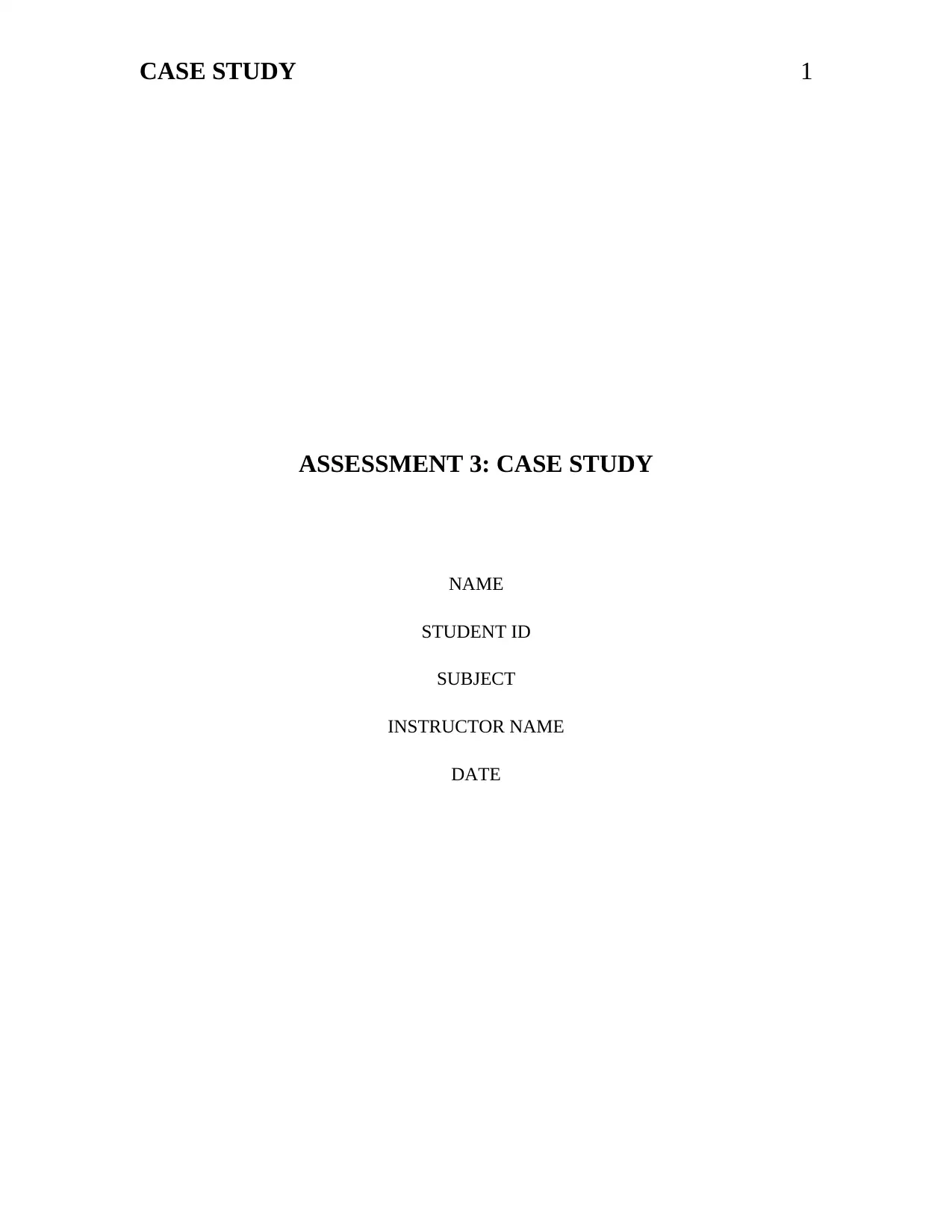
CASE STUDY 1
ASSESSMENT 3: CASE STUDY
NAME
STUDENT ID
SUBJECT
INSTRUCTOR NAME
DATE
ASSESSMENT 3: CASE STUDY
NAME
STUDENT ID
SUBJECT
INSTRUCTOR NAME
DATE
Paraphrase This Document
Need a fresh take? Get an instant paraphrase of this document with our AI Paraphraser
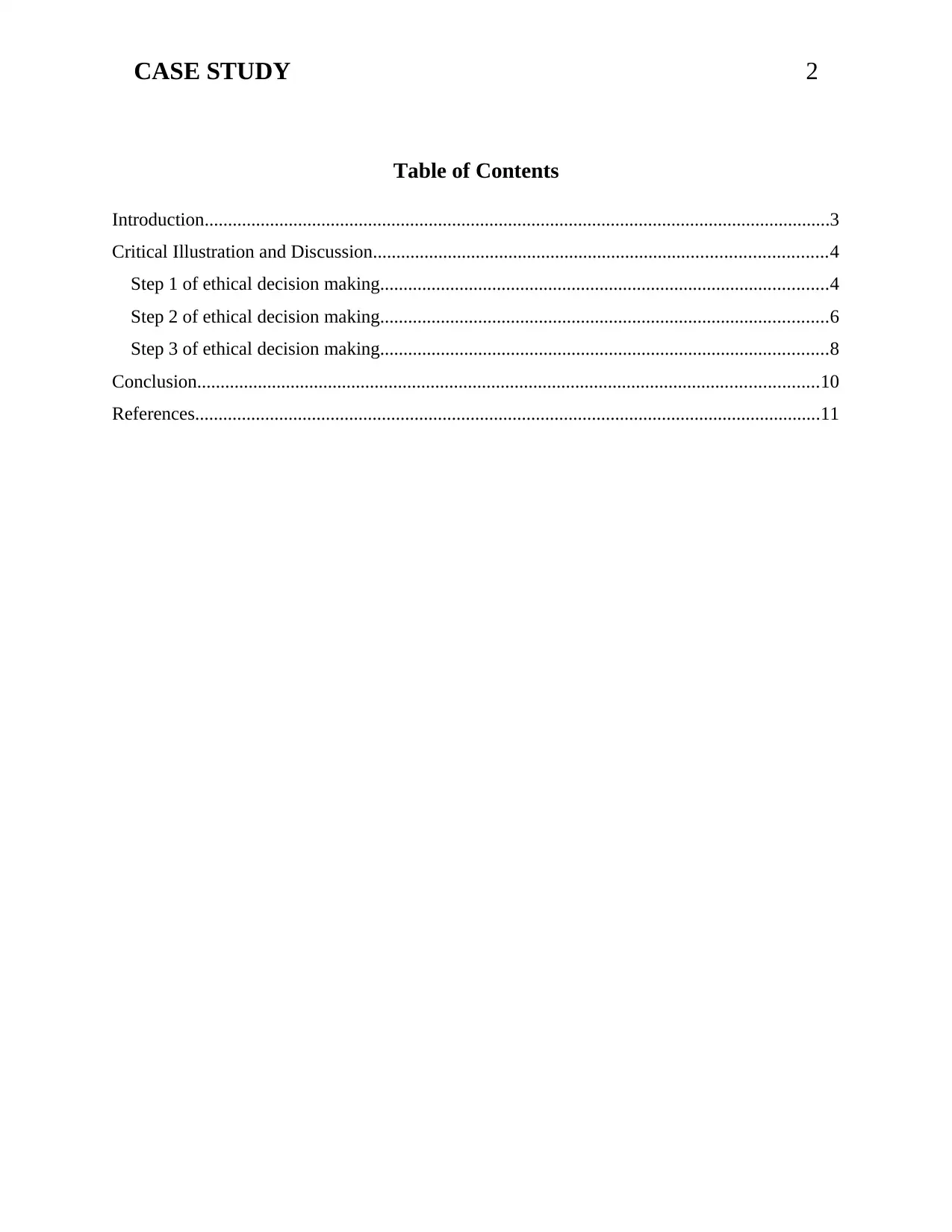
CASE STUDY 2
Table of Contents
Introduction......................................................................................................................................3
Critical Illustration and Discussion.................................................................................................4
Step 1 of ethical decision making................................................................................................4
Step 2 of ethical decision making................................................................................................6
Step 3 of ethical decision making................................................................................................8
Conclusion.....................................................................................................................................10
References......................................................................................................................................11
Table of Contents
Introduction......................................................................................................................................3
Critical Illustration and Discussion.................................................................................................4
Step 1 of ethical decision making................................................................................................4
Step 2 of ethical decision making................................................................................................6
Step 3 of ethical decision making................................................................................................8
Conclusion.....................................................................................................................................10
References......................................................................................................................................11
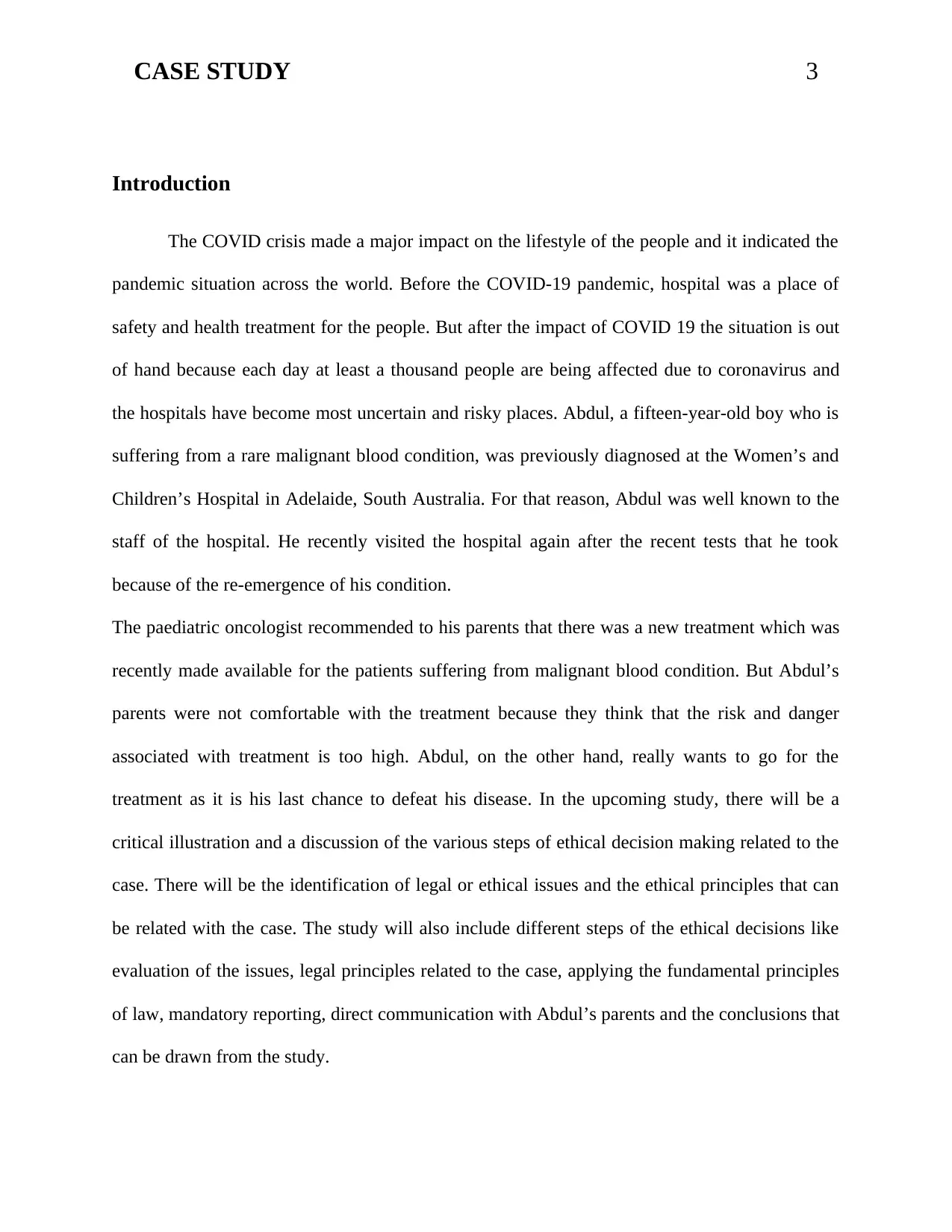
CASE STUDY 3
Introduction
The COVID crisis made a major impact on the lifestyle of the people and it indicated the
pandemic situation across the world. Before the COVID-19 pandemic, hospital was a place of
safety and health treatment for the people. But after the impact of COVID 19 the situation is out
of hand because each day at least a thousand people are being affected due to coronavirus and
the hospitals have become most uncertain and risky places. Abdul, a fifteen-year-old boy who is
suffering from a rare malignant blood condition, was previously diagnosed at the Women’s and
Children’s Hospital in Adelaide, South Australia. For that reason, Abdul was well known to the
staff of the hospital. He recently visited the hospital again after the recent tests that he took
because of the re-emergence of his condition.
The paediatric oncologist recommended to his parents that there was a new treatment which was
recently made available for the patients suffering from malignant blood condition. But Abdul’s
parents were not comfortable with the treatment because they think that the risk and danger
associated with treatment is too high. Abdul, on the other hand, really wants to go for the
treatment as it is his last chance to defeat his disease. In the upcoming study, there will be a
critical illustration and a discussion of the various steps of ethical decision making related to the
case. There will be the identification of legal or ethical issues and the ethical principles that can
be related with the case. The study will also include different steps of the ethical decisions like
evaluation of the issues, legal principles related to the case, applying the fundamental principles
of law, mandatory reporting, direct communication with Abdul’s parents and the conclusions that
can be drawn from the study.
Introduction
The COVID crisis made a major impact on the lifestyle of the people and it indicated the
pandemic situation across the world. Before the COVID-19 pandemic, hospital was a place of
safety and health treatment for the people. But after the impact of COVID 19 the situation is out
of hand because each day at least a thousand people are being affected due to coronavirus and
the hospitals have become most uncertain and risky places. Abdul, a fifteen-year-old boy who is
suffering from a rare malignant blood condition, was previously diagnosed at the Women’s and
Children’s Hospital in Adelaide, South Australia. For that reason, Abdul was well known to the
staff of the hospital. He recently visited the hospital again after the recent tests that he took
because of the re-emergence of his condition.
The paediatric oncologist recommended to his parents that there was a new treatment which was
recently made available for the patients suffering from malignant blood condition. But Abdul’s
parents were not comfortable with the treatment because they think that the risk and danger
associated with treatment is too high. Abdul, on the other hand, really wants to go for the
treatment as it is his last chance to defeat his disease. In the upcoming study, there will be a
critical illustration and a discussion of the various steps of ethical decision making related to the
case. There will be the identification of legal or ethical issues and the ethical principles that can
be related with the case. The study will also include different steps of the ethical decisions like
evaluation of the issues, legal principles related to the case, applying the fundamental principles
of law, mandatory reporting, direct communication with Abdul’s parents and the conclusions that
can be drawn from the study.
⊘ This is a preview!⊘
Do you want full access?
Subscribe today to unlock all pages.

Trusted by 1+ million students worldwide
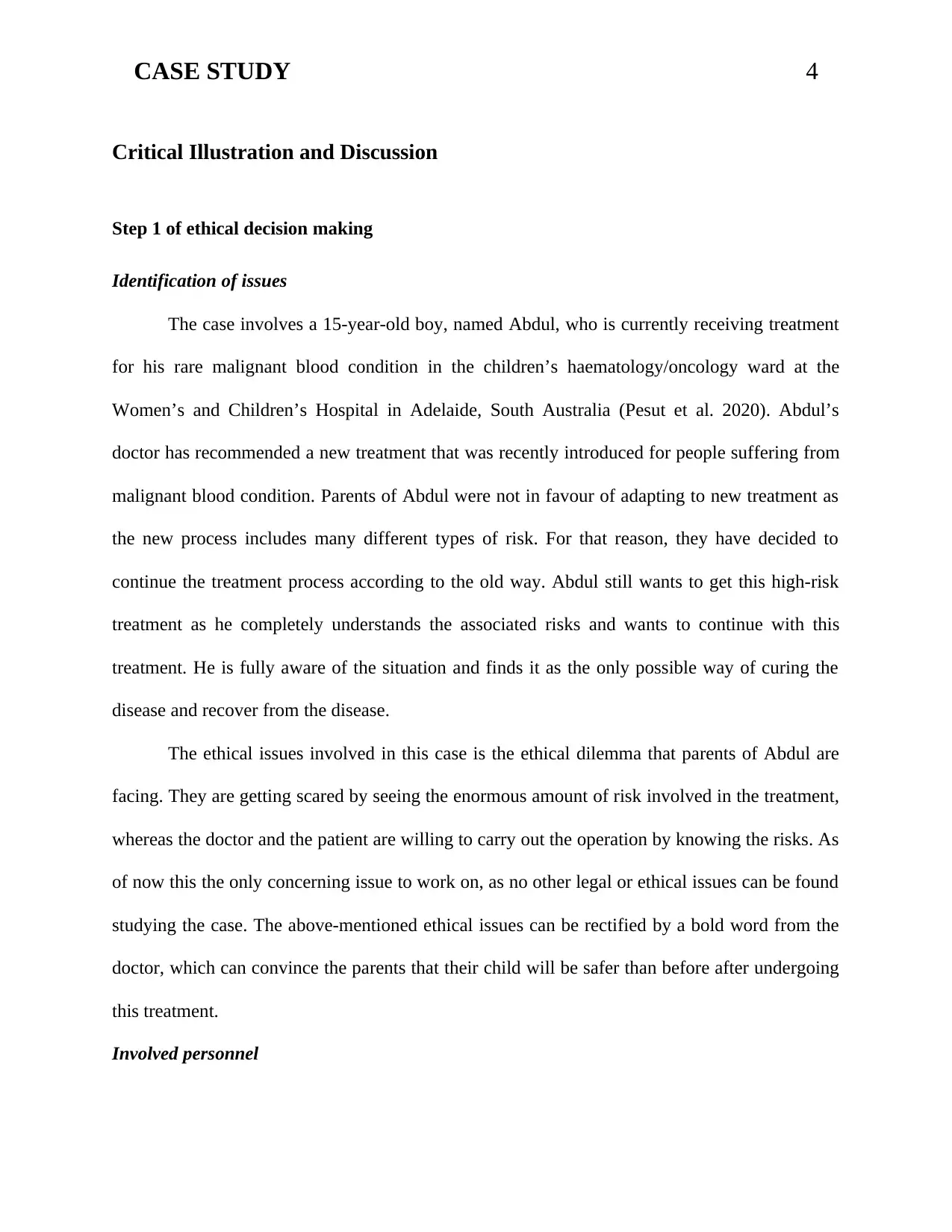
CASE STUDY 4
Critical Illustration and Discussion
Step 1 of ethical decision making
Identification of issues
The case involves a 15-year-old boy, named Abdul, who is currently receiving treatment
for his rare malignant blood condition in the children’s haematology/oncology ward at the
Women’s and Children’s Hospital in Adelaide, South Australia (Pesut et al. 2020). Abdul’s
doctor has recommended a new treatment that was recently introduced for people suffering from
malignant blood condition. Parents of Abdul were not in favour of adapting to new treatment as
the new process includes many different types of risk. For that reason, they have decided to
continue the treatment process according to the old way. Abdul still wants to get this high-risk
treatment as he completely understands the associated risks and wants to continue with this
treatment. He is fully aware of the situation and finds it as the only possible way of curing the
disease and recover from the disease.
The ethical issues involved in this case is the ethical dilemma that parents of Abdul are
facing. They are getting scared by seeing the enormous amount of risk involved in the treatment,
whereas the doctor and the patient are willing to carry out the operation by knowing the risks. As
of now this the only concerning issue to work on, as no other legal or ethical issues can be found
studying the case. The above-mentioned ethical issues can be rectified by a bold word from the
doctor, which can convince the parents that their child will be safer than before after undergoing
this treatment.
Involved personnel
Critical Illustration and Discussion
Step 1 of ethical decision making
Identification of issues
The case involves a 15-year-old boy, named Abdul, who is currently receiving treatment
for his rare malignant blood condition in the children’s haematology/oncology ward at the
Women’s and Children’s Hospital in Adelaide, South Australia (Pesut et al. 2020). Abdul’s
doctor has recommended a new treatment that was recently introduced for people suffering from
malignant blood condition. Parents of Abdul were not in favour of adapting to new treatment as
the new process includes many different types of risk. For that reason, they have decided to
continue the treatment process according to the old way. Abdul still wants to get this high-risk
treatment as he completely understands the associated risks and wants to continue with this
treatment. He is fully aware of the situation and finds it as the only possible way of curing the
disease and recover from the disease.
The ethical issues involved in this case is the ethical dilemma that parents of Abdul are
facing. They are getting scared by seeing the enormous amount of risk involved in the treatment,
whereas the doctor and the patient are willing to carry out the operation by knowing the risks. As
of now this the only concerning issue to work on, as no other legal or ethical issues can be found
studying the case. The above-mentioned ethical issues can be rectified by a bold word from the
doctor, which can convince the parents that their child will be safer than before after undergoing
this treatment.
Involved personnel
Paraphrase This Document
Need a fresh take? Get an instant paraphrase of this document with our AI Paraphraser
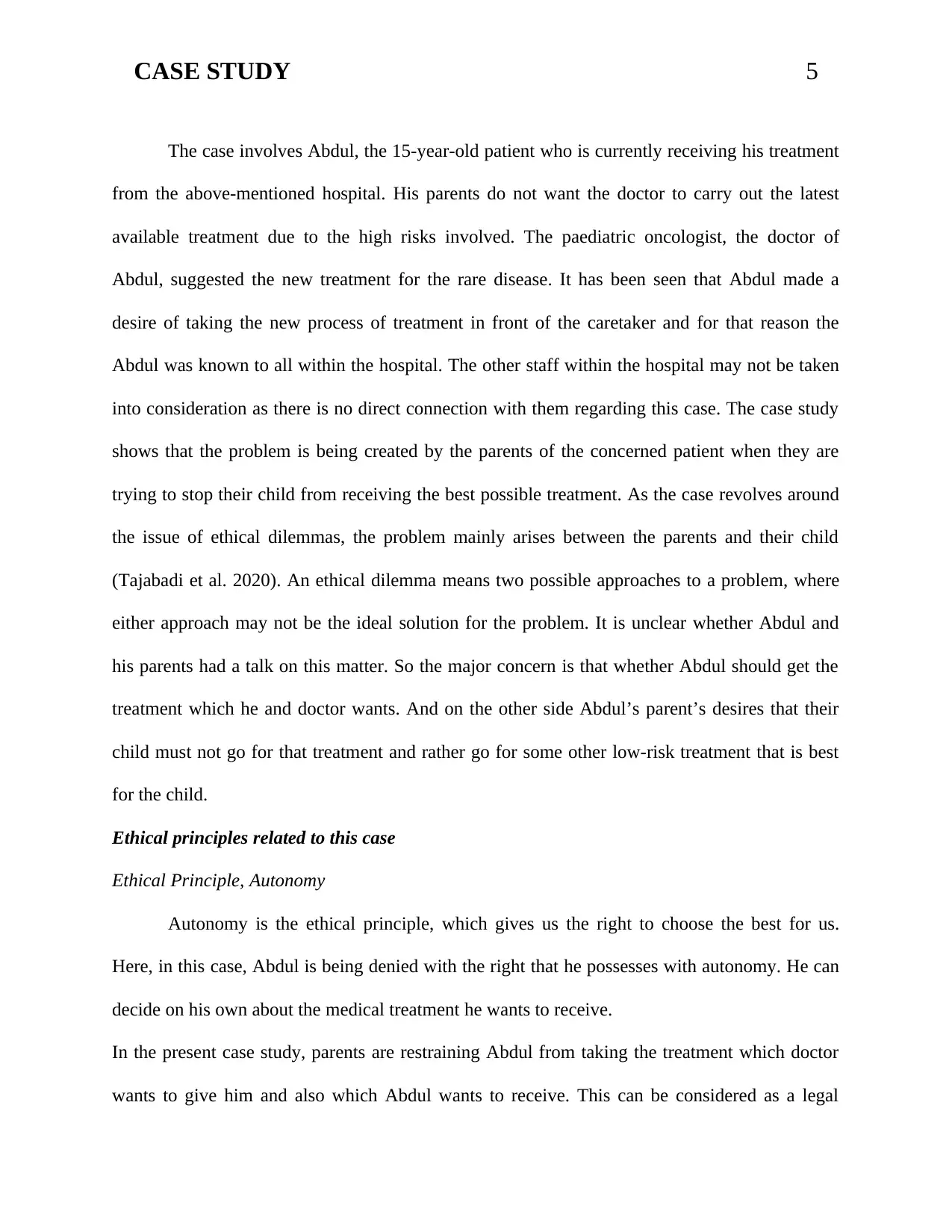
CASE STUDY 5
The case involves Abdul, the 15-year-old patient who is currently receiving his treatment
from the above-mentioned hospital. His parents do not want the doctor to carry out the latest
available treatment due to the high risks involved. The paediatric oncologist, the doctor of
Abdul, suggested the new treatment for the rare disease. It has been seen that Abdul made a
desire of taking the new process of treatment in front of the caretaker and for that reason the
Abdul was known to all within the hospital. The other staff within the hospital may not be taken
into consideration as there is no direct connection with them regarding this case. The case study
shows that the problem is being created by the parents of the concerned patient when they are
trying to stop their child from receiving the best possible treatment. As the case revolves around
the issue of ethical dilemmas, the problem mainly arises between the parents and their child
(Tajabadi et al. 2020). An ethical dilemma means two possible approaches to a problem, where
either approach may not be the ideal solution for the problem. It is unclear whether Abdul and
his parents had a talk on this matter. So the major concern is that whether Abdul should get the
treatment which he and doctor wants. And on the other side Abdul’s parent’s desires that their
child must not go for that treatment and rather go for some other low-risk treatment that is best
for the child.
Ethical principles related to this case
Ethical Principle, Autonomy
Autonomy is the ethical principle, which gives us the right to choose the best for us.
Here, in this case, Abdul is being denied with the right that he possesses with autonomy. He can
decide on his own about the medical treatment he wants to receive.
In the present case study, parents are restraining Abdul from taking the treatment which doctor
wants to give him and also which Abdul wants to receive. This can be considered as a legal
The case involves Abdul, the 15-year-old patient who is currently receiving his treatment
from the above-mentioned hospital. His parents do not want the doctor to carry out the latest
available treatment due to the high risks involved. The paediatric oncologist, the doctor of
Abdul, suggested the new treatment for the rare disease. It has been seen that Abdul made a
desire of taking the new process of treatment in front of the caretaker and for that reason the
Abdul was known to all within the hospital. The other staff within the hospital may not be taken
into consideration as there is no direct connection with them regarding this case. The case study
shows that the problem is being created by the parents of the concerned patient when they are
trying to stop their child from receiving the best possible treatment. As the case revolves around
the issue of ethical dilemmas, the problem mainly arises between the parents and their child
(Tajabadi et al. 2020). An ethical dilemma means two possible approaches to a problem, where
either approach may not be the ideal solution for the problem. It is unclear whether Abdul and
his parents had a talk on this matter. So the major concern is that whether Abdul should get the
treatment which he and doctor wants. And on the other side Abdul’s parent’s desires that their
child must not go for that treatment and rather go for some other low-risk treatment that is best
for the child.
Ethical principles related to this case
Ethical Principle, Autonomy
Autonomy is the ethical principle, which gives us the right to choose the best for us.
Here, in this case, Abdul is being denied with the right that he possesses with autonomy. He can
decide on his own about the medical treatment he wants to receive.
In the present case study, parents are restraining Abdul from taking the treatment which doctor
wants to give him and also which Abdul wants to receive. This can be considered as a legal
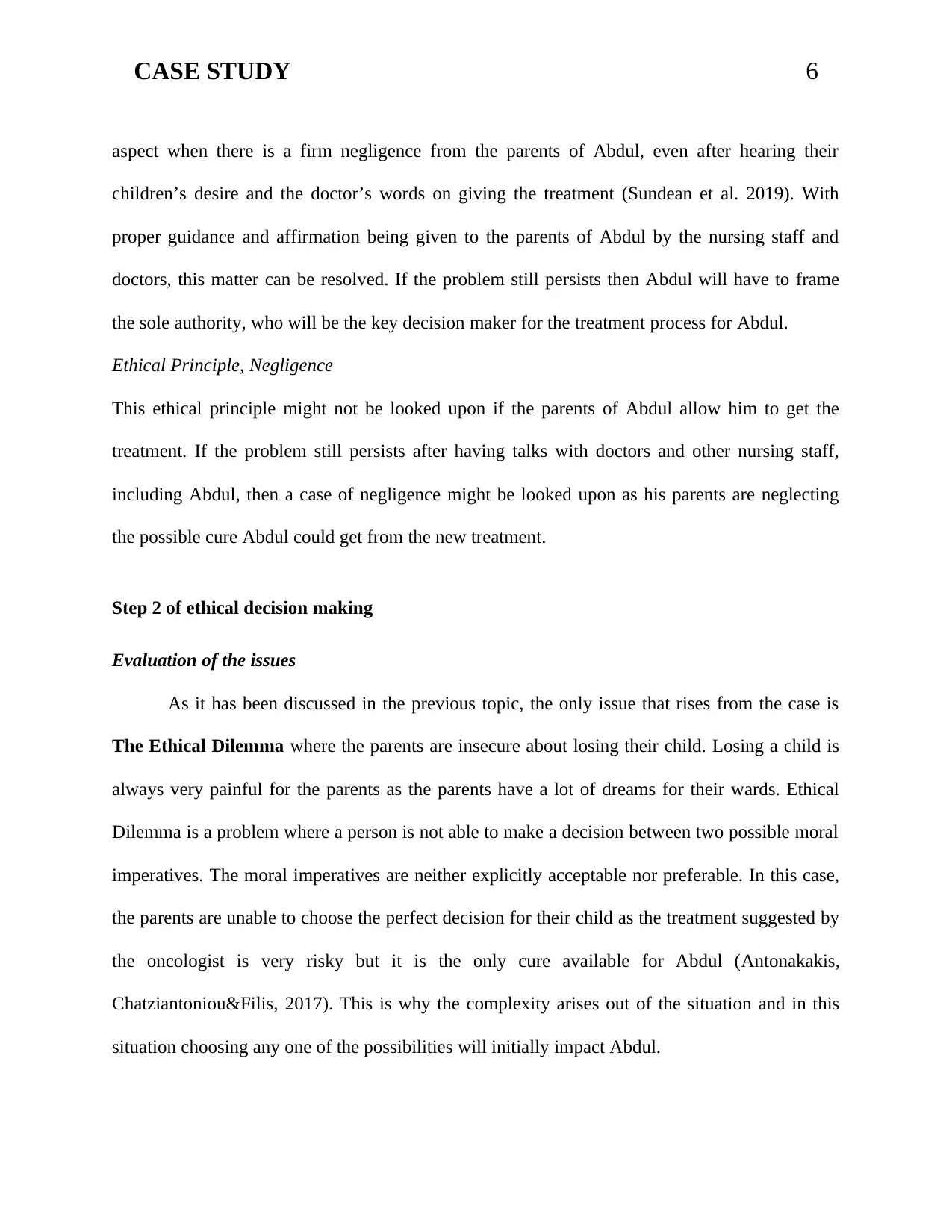
CASE STUDY 6
aspect when there is a firm negligence from the parents of Abdul, even after hearing their
children’s desire and the doctor’s words on giving the treatment (Sundean et al. 2019). With
proper guidance and affirmation being given to the parents of Abdul by the nursing staff and
doctors, this matter can be resolved. If the problem still persists then Abdul will have to frame
the sole authority, who will be the key decision maker for the treatment process for Abdul.
Ethical Principle, Negligence
This ethical principle might not be looked upon if the parents of Abdul allow him to get the
treatment. If the problem still persists after having talks with doctors and other nursing staff,
including Abdul, then a case of negligence might be looked upon as his parents are neglecting
the possible cure Abdul could get from the new treatment.
Step 2 of ethical decision making
Evaluation of the issues
As it has been discussed in the previous topic, the only issue that rises from the case is
The Ethical Dilemma where the parents are insecure about losing their child. Losing a child is
always very painful for the parents as the parents have a lot of dreams for their wards. Ethical
Dilemma is a problem where a person is not able to make a decision between two possible moral
imperatives. The moral imperatives are neither explicitly acceptable nor preferable. In this case,
the parents are unable to choose the perfect decision for their child as the treatment suggested by
the oncologist is very risky but it is the only cure available for Abdul (Antonakakis,
Chatziantoniou&Filis, 2017). This is why the complexity arises out of the situation and in this
situation choosing any one of the possibilities will initially impact Abdul.
aspect when there is a firm negligence from the parents of Abdul, even after hearing their
children’s desire and the doctor’s words on giving the treatment (Sundean et al. 2019). With
proper guidance and affirmation being given to the parents of Abdul by the nursing staff and
doctors, this matter can be resolved. If the problem still persists then Abdul will have to frame
the sole authority, who will be the key decision maker for the treatment process for Abdul.
Ethical Principle, Negligence
This ethical principle might not be looked upon if the parents of Abdul allow him to get the
treatment. If the problem still persists after having talks with doctors and other nursing staff,
including Abdul, then a case of negligence might be looked upon as his parents are neglecting
the possible cure Abdul could get from the new treatment.
Step 2 of ethical decision making
Evaluation of the issues
As it has been discussed in the previous topic, the only issue that rises from the case is
The Ethical Dilemma where the parents are insecure about losing their child. Losing a child is
always very painful for the parents as the parents have a lot of dreams for their wards. Ethical
Dilemma is a problem where a person is not able to make a decision between two possible moral
imperatives. The moral imperatives are neither explicitly acceptable nor preferable. In this case,
the parents are unable to choose the perfect decision for their child as the treatment suggested by
the oncologist is very risky but it is the only cure available for Abdul (Antonakakis,
Chatziantoniou&Filis, 2017). This is why the complexity arises out of the situation and in this
situation choosing any one of the possibilities will initially impact Abdul.
⊘ This is a preview!⊘
Do you want full access?
Subscribe today to unlock all pages.

Trusted by 1+ million students worldwide
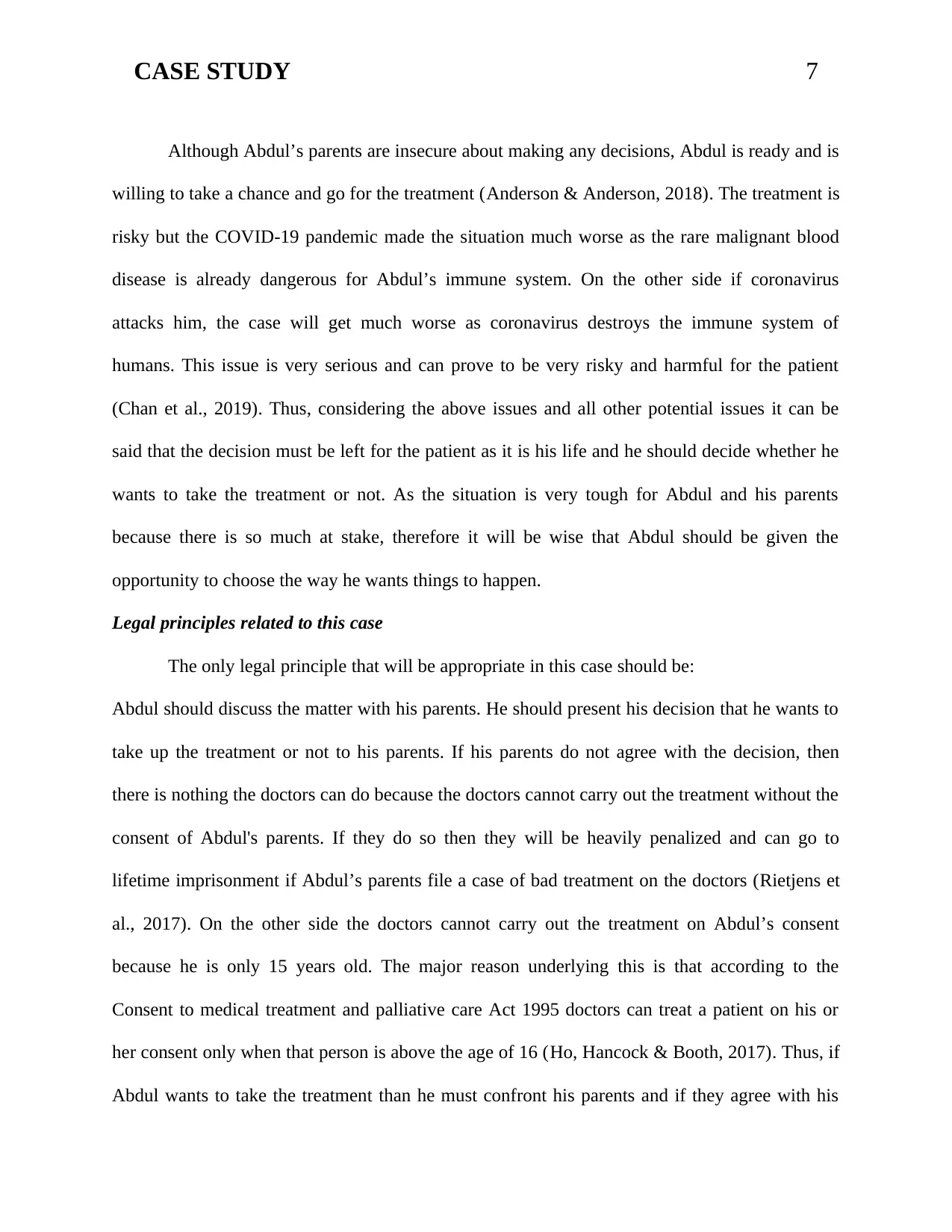
CASE STUDY 7
Although Abdul’s parents are insecure about making any decisions, Abdul is ready and is
willing to take a chance and go for the treatment (Anderson & Anderson, 2018). The treatment is
risky but the COVID-19 pandemic made the situation much worse as the rare malignant blood
disease is already dangerous for Abdul’s immune system. On the other side if coronavirus
attacks him, the case will get much worse as coronavirus destroys the immune system of
humans. This issue is very serious and can prove to be very risky and harmful for the patient
(Chan et al., 2019). Thus, considering the above issues and all other potential issues it can be
said that the decision must be left for the patient as it is his life and he should decide whether he
wants to take the treatment or not. As the situation is very tough for Abdul and his parents
because there is so much at stake, therefore it will be wise that Abdul should be given the
opportunity to choose the way he wants things to happen.
Legal principles related to this case
The only legal principle that will be appropriate in this case should be:
Abdul should discuss the matter with his parents. He should present his decision that he wants to
take up the treatment or not to his parents. If his parents do not agree with the decision, then
there is nothing the doctors can do because the doctors cannot carry out the treatment without the
consent of Abdul's parents. If they do so then they will be heavily penalized and can go to
lifetime imprisonment if Abdul’s parents file a case of bad treatment on the doctors (Rietjens et
al., 2017). On the other side the doctors cannot carry out the treatment on Abdul’s consent
because he is only 15 years old. The major reason underlying this is that according to the
Consent to medical treatment and palliative care Act 1995 doctors can treat a patient on his or
her consent only when that person is above the age of 16 (Ho, Hancock & Booth, 2017). Thus, if
Abdul wants to take the treatment than he must confront his parents and if they agree with his
Although Abdul’s parents are insecure about making any decisions, Abdul is ready and is
willing to take a chance and go for the treatment (Anderson & Anderson, 2018). The treatment is
risky but the COVID-19 pandemic made the situation much worse as the rare malignant blood
disease is already dangerous for Abdul’s immune system. On the other side if coronavirus
attacks him, the case will get much worse as coronavirus destroys the immune system of
humans. This issue is very serious and can prove to be very risky and harmful for the patient
(Chan et al., 2019). Thus, considering the above issues and all other potential issues it can be
said that the decision must be left for the patient as it is his life and he should decide whether he
wants to take the treatment or not. As the situation is very tough for Abdul and his parents
because there is so much at stake, therefore it will be wise that Abdul should be given the
opportunity to choose the way he wants things to happen.
Legal principles related to this case
The only legal principle that will be appropriate in this case should be:
Abdul should discuss the matter with his parents. He should present his decision that he wants to
take up the treatment or not to his parents. If his parents do not agree with the decision, then
there is nothing the doctors can do because the doctors cannot carry out the treatment without the
consent of Abdul's parents. If they do so then they will be heavily penalized and can go to
lifetime imprisonment if Abdul’s parents file a case of bad treatment on the doctors (Rietjens et
al., 2017). On the other side the doctors cannot carry out the treatment on Abdul’s consent
because he is only 15 years old. The major reason underlying this is that according to the
Consent to medical treatment and palliative care Act 1995 doctors can treat a patient on his or
her consent only when that person is above the age of 16 (Ho, Hancock & Booth, 2017). Thus, if
Abdul wants to take the treatment than he must confront his parents and if they agree with his
Paraphrase This Document
Need a fresh take? Get an instant paraphrase of this document with our AI Paraphraser
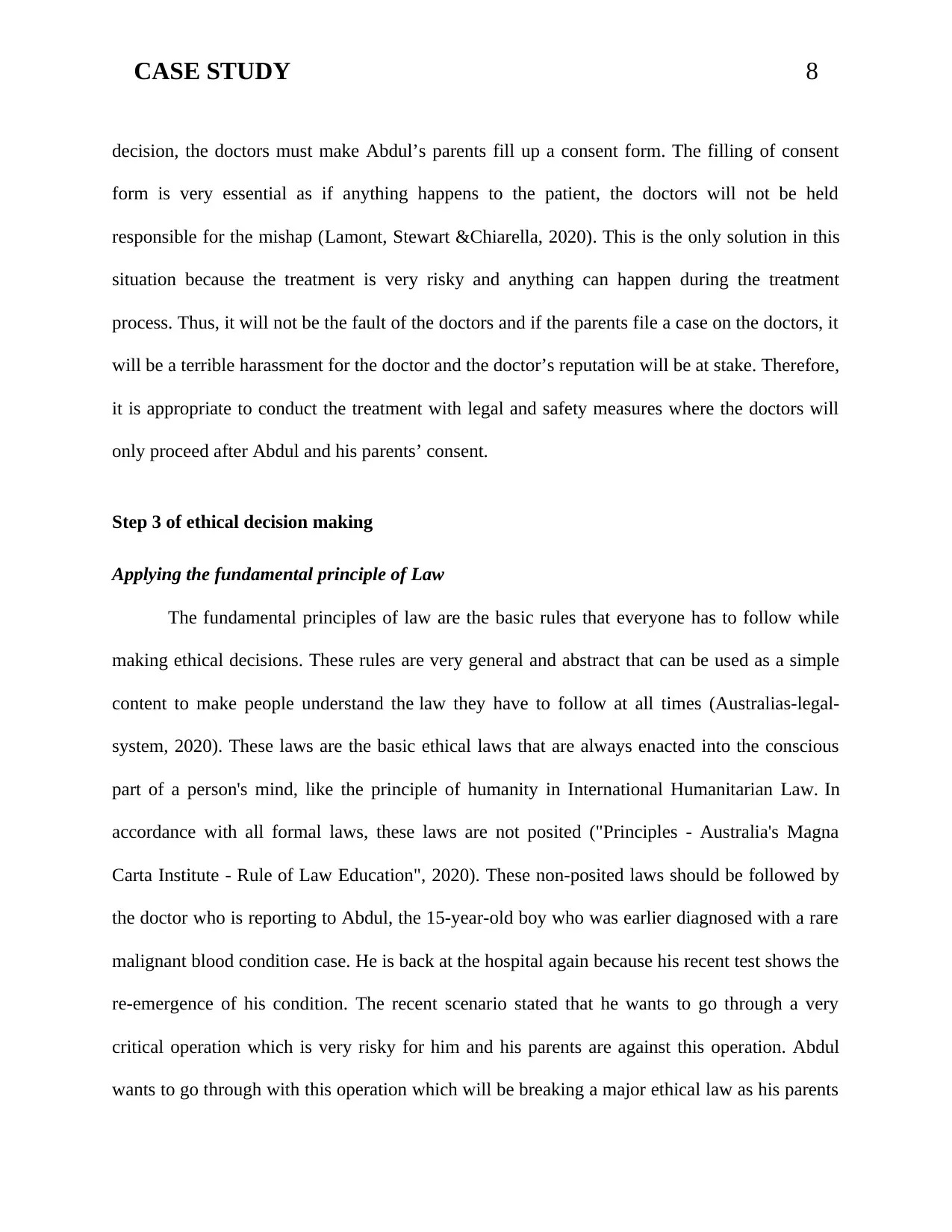
CASE STUDY 8
decision, the doctors must make Abdul’s parents fill up a consent form. The filling of consent
form is very essential as if anything happens to the patient, the doctors will not be held
responsible for the mishap (Lamont, Stewart &Chiarella, 2020). This is the only solution in this
situation because the treatment is very risky and anything can happen during the treatment
process. Thus, it will not be the fault of the doctors and if the parents file a case on the doctors, it
will be a terrible harassment for the doctor and the doctor’s reputation will be at stake. Therefore,
it is appropriate to conduct the treatment with legal and safety measures where the doctors will
only proceed after Abdul and his parents’ consent.
Step 3 of ethical decision making
Applying the fundamental principle of Law
The fundamental principles of law are the basic rules that everyone has to follow while
making ethical decisions. These rules are very general and abstract that can be used as a simple
content to make people understand the law they have to follow at all times (Australias-legal-
system, 2020). These laws are the basic ethical laws that are always enacted into the conscious
part of a person's mind, like the principle of humanity in International Humanitarian Law. In
accordance with all formal laws, these laws are not posited ("Principles - Australia's Magna
Carta Institute - Rule of Law Education", 2020). These non-posited laws should be followed by
the doctor who is reporting to Abdul, the 15-year-old boy who was earlier diagnosed with a rare
malignant blood condition case. He is back at the hospital again because his recent test shows the
re-emergence of his condition. The recent scenario stated that he wants to go through a very
critical operation which is very risky for him and his parents are against this operation. Abdul
wants to go through with this operation which will be breaking a major ethical law as his parents
decision, the doctors must make Abdul’s parents fill up a consent form. The filling of consent
form is very essential as if anything happens to the patient, the doctors will not be held
responsible for the mishap (Lamont, Stewart &Chiarella, 2020). This is the only solution in this
situation because the treatment is very risky and anything can happen during the treatment
process. Thus, it will not be the fault of the doctors and if the parents file a case on the doctors, it
will be a terrible harassment for the doctor and the doctor’s reputation will be at stake. Therefore,
it is appropriate to conduct the treatment with legal and safety measures where the doctors will
only proceed after Abdul and his parents’ consent.
Step 3 of ethical decision making
Applying the fundamental principle of Law
The fundamental principles of law are the basic rules that everyone has to follow while
making ethical decisions. These rules are very general and abstract that can be used as a simple
content to make people understand the law they have to follow at all times (Australias-legal-
system, 2020). These laws are the basic ethical laws that are always enacted into the conscious
part of a person's mind, like the principle of humanity in International Humanitarian Law. In
accordance with all formal laws, these laws are not posited ("Principles - Australia's Magna
Carta Institute - Rule of Law Education", 2020). These non-posited laws should be followed by
the doctor who is reporting to Abdul, the 15-year-old boy who was earlier diagnosed with a rare
malignant blood condition case. He is back at the hospital again because his recent test shows the
re-emergence of his condition. The recent scenario stated that he wants to go through a very
critical operation which is very risky for him and his parents are against this operation. Abdul
wants to go through with this operation which will be breaking a major ethical law as his parents
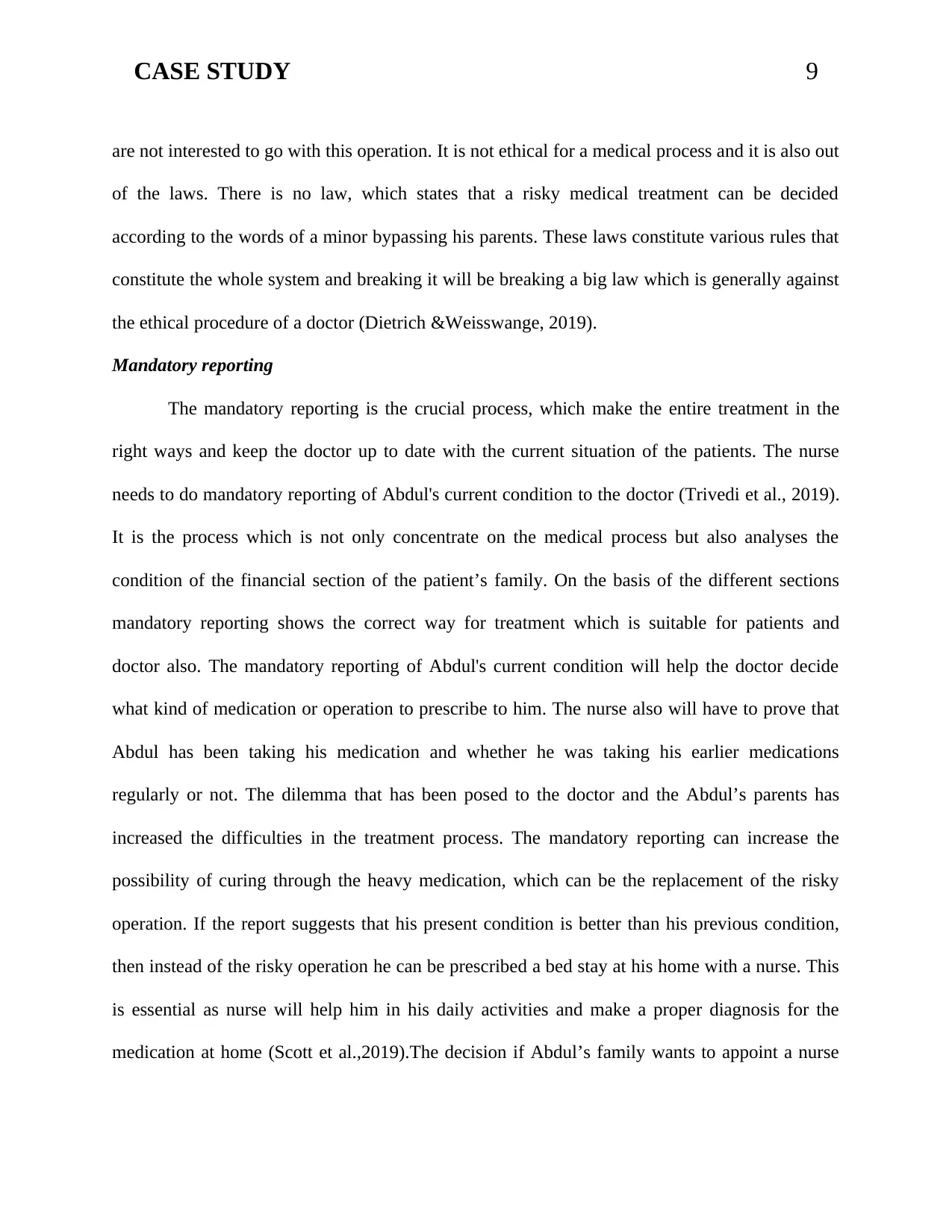
CASE STUDY 9
are not interested to go with this operation. It is not ethical for a medical process and it is also out
of the laws. There is no law, which states that a risky medical treatment can be decided
according to the words of a minor bypassing his parents. These laws constitute various rules that
constitute the whole system and breaking it will be breaking a big law which is generally against
the ethical procedure of a doctor (Dietrich &Weisswange, 2019).
Mandatory reporting
The mandatory reporting is the crucial process, which make the entire treatment in the
right ways and keep the doctor up to date with the current situation of the patients. The nurse
needs to do mandatory reporting of Abdul's current condition to the doctor (Trivedi et al., 2019).
It is the process which is not only concentrate on the medical process but also analyses the
condition of the financial section of the patient’s family. On the basis of the different sections
mandatory reporting shows the correct way for treatment which is suitable for patients and
doctor also. The mandatory reporting of Abdul's current condition will help the doctor decide
what kind of medication or operation to prescribe to him. The nurse also will have to prove that
Abdul has been taking his medication and whether he was taking his earlier medications
regularly or not. The dilemma that has been posed to the doctor and the Abdul’s parents has
increased the difficulties in the treatment process. The mandatory reporting can increase the
possibility of curing through the heavy medication, which can be the replacement of the risky
operation. If the report suggests that his present condition is better than his previous condition,
then instead of the risky operation he can be prescribed a bed stay at his home with a nurse. This
is essential as nurse will help him in his daily activities and make a proper diagnosis for the
medication at home (Scott et al.,2019).The decision if Abdul’s family wants to appoint a nurse
are not interested to go with this operation. It is not ethical for a medical process and it is also out
of the laws. There is no law, which states that a risky medical treatment can be decided
according to the words of a minor bypassing his parents. These laws constitute various rules that
constitute the whole system and breaking it will be breaking a big law which is generally against
the ethical procedure of a doctor (Dietrich &Weisswange, 2019).
Mandatory reporting
The mandatory reporting is the crucial process, which make the entire treatment in the
right ways and keep the doctor up to date with the current situation of the patients. The nurse
needs to do mandatory reporting of Abdul's current condition to the doctor (Trivedi et al., 2019).
It is the process which is not only concentrate on the medical process but also analyses the
condition of the financial section of the patient’s family. On the basis of the different sections
mandatory reporting shows the correct way for treatment which is suitable for patients and
doctor also. The mandatory reporting of Abdul's current condition will help the doctor decide
what kind of medication or operation to prescribe to him. The nurse also will have to prove that
Abdul has been taking his medication and whether he was taking his earlier medications
regularly or not. The dilemma that has been posed to the doctor and the Abdul’s parents has
increased the difficulties in the treatment process. The mandatory reporting can increase the
possibility of curing through the heavy medication, which can be the replacement of the risky
operation. If the report suggests that his present condition is better than his previous condition,
then instead of the risky operation he can be prescribed a bed stay at his home with a nurse. This
is essential as nurse will help him in his daily activities and make a proper diagnosis for the
medication at home (Scott et al.,2019).The decision if Abdul’s family wants to appoint a nurse
⊘ This is a preview!⊘
Do you want full access?
Subscribe today to unlock all pages.

Trusted by 1+ million students worldwide
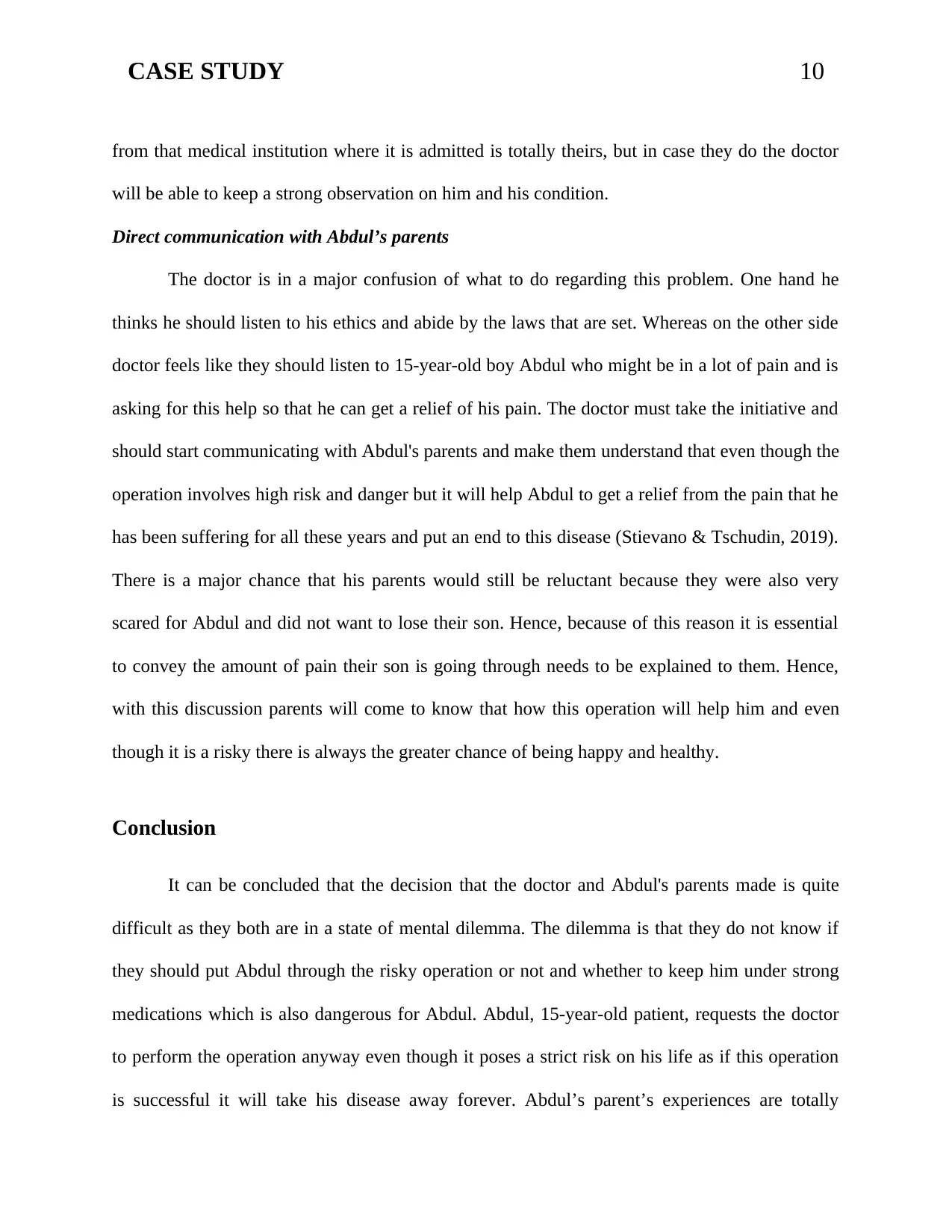
CASE STUDY 10
from that medical institution where it is admitted is totally theirs, but in case they do the doctor
will be able to keep a strong observation on him and his condition.
Direct communication with Abdul’s parents
The doctor is in a major confusion of what to do regarding this problem. One hand he
thinks he should listen to his ethics and abide by the laws that are set. Whereas on the other side
doctor feels like they should listen to 15-year-old boy Abdul who might be in a lot of pain and is
asking for this help so that he can get a relief of his pain. The doctor must take the initiative and
should start communicating with Abdul's parents and make them understand that even though the
operation involves high risk and danger but it will help Abdul to get a relief from the pain that he
has been suffering for all these years and put an end to this disease (Stievano & Tschudin, 2019).
There is a major chance that his parents would still be reluctant because they were also very
scared for Abdul and did not want to lose their son. Hence, because of this reason it is essential
to convey the amount of pain their son is going through needs to be explained to them. Hence,
with this discussion parents will come to know that how this operation will help him and even
though it is a risky there is always the greater chance of being happy and healthy.
Conclusion
It can be concluded that the decision that the doctor and Abdul's parents made is quite
difficult as they both are in a state of mental dilemma. The dilemma is that they do not know if
they should put Abdul through the risky operation or not and whether to keep him under strong
medications which is also dangerous for Abdul. Abdul, 15-year-old patient, requests the doctor
to perform the operation anyway even though it poses a strict risk on his life as if this operation
is successful it will take his disease away forever. Abdul’s parent’s experiences are totally
from that medical institution where it is admitted is totally theirs, but in case they do the doctor
will be able to keep a strong observation on him and his condition.
Direct communication with Abdul’s parents
The doctor is in a major confusion of what to do regarding this problem. One hand he
thinks he should listen to his ethics and abide by the laws that are set. Whereas on the other side
doctor feels like they should listen to 15-year-old boy Abdul who might be in a lot of pain and is
asking for this help so that he can get a relief of his pain. The doctor must take the initiative and
should start communicating with Abdul's parents and make them understand that even though the
operation involves high risk and danger but it will help Abdul to get a relief from the pain that he
has been suffering for all these years and put an end to this disease (Stievano & Tschudin, 2019).
There is a major chance that his parents would still be reluctant because they were also very
scared for Abdul and did not want to lose their son. Hence, because of this reason it is essential
to convey the amount of pain their son is going through needs to be explained to them. Hence,
with this discussion parents will come to know that how this operation will help him and even
though it is a risky there is always the greater chance of being happy and healthy.
Conclusion
It can be concluded that the decision that the doctor and Abdul's parents made is quite
difficult as they both are in a state of mental dilemma. The dilemma is that they do not know if
they should put Abdul through the risky operation or not and whether to keep him under strong
medications which is also dangerous for Abdul. Abdul, 15-year-old patient, requests the doctor
to perform the operation anyway even though it poses a strict risk on his life as if this operation
is successful it will take his disease away forever. Abdul’s parent’s experiences are totally
Paraphrase This Document
Need a fresh take? Get an instant paraphrase of this document with our AI Paraphraser
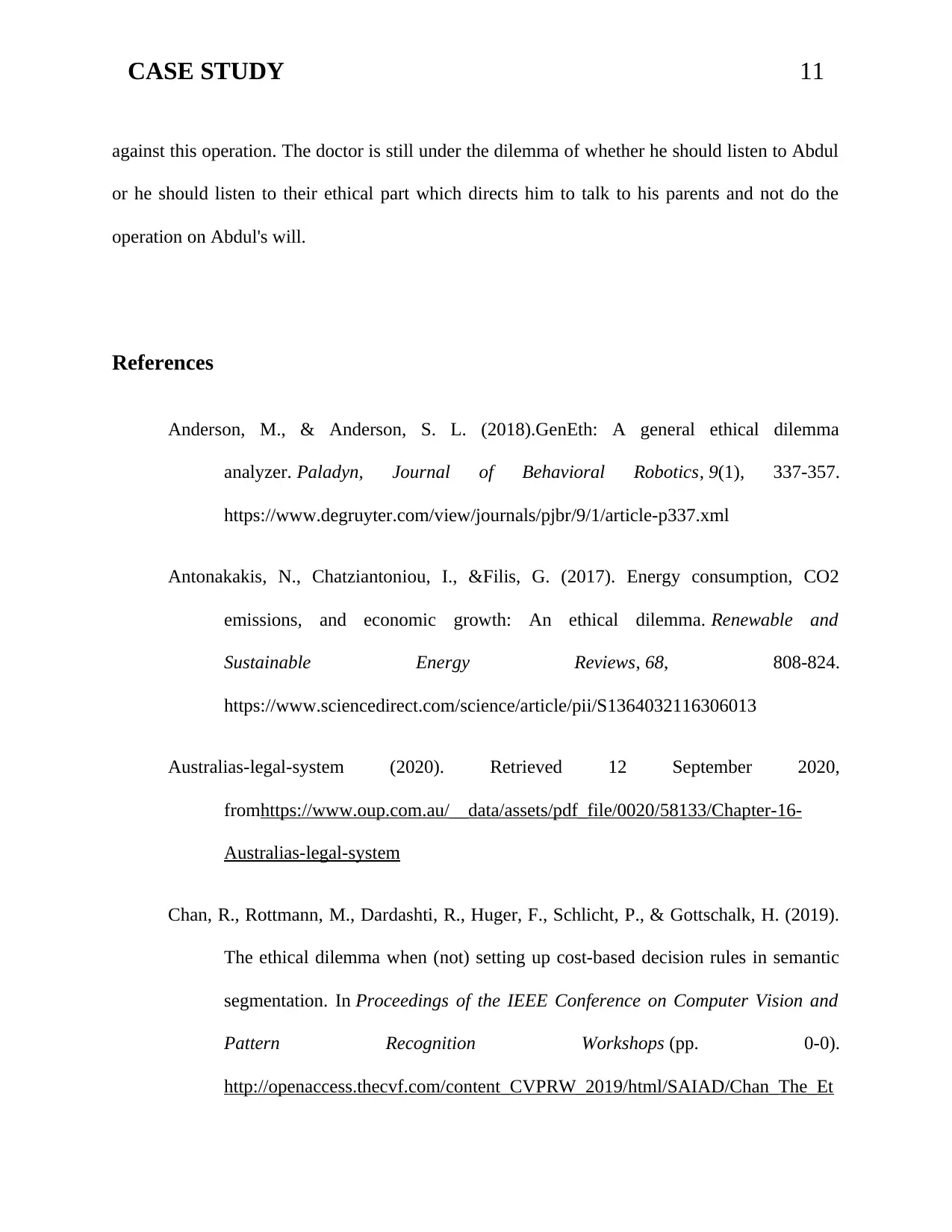
CASE STUDY 11
against this operation. The doctor is still under the dilemma of whether he should listen to Abdul
or he should listen to their ethical part which directs him to talk to his parents and not do the
operation on Abdul's will.
References
Anderson, M., & Anderson, S. L. (2018).GenEth: A general ethical dilemma
analyzer. Paladyn, Journal of Behavioral Robotics, 9(1), 337-357.
https://www.degruyter.com/view/journals/pjbr/9/1/article-p337.xml
Antonakakis, N., Chatziantoniou, I., &Filis, G. (2017). Energy consumption, CO2
emissions, and economic growth: An ethical dilemma. Renewable and
Sustainable Energy Reviews, 68, 808-824.
https://www.sciencedirect.com/science/article/pii/S1364032116306013
Australias-legal-system (2020). Retrieved 12 September 2020,
fromhttps://www.oup.com.au/__data/assets/pdf_file/0020/58133/Chapter-16-
Australias-legal-system
Chan, R., Rottmann, M., Dardashti, R., Huger, F., Schlicht, P., & Gottschalk, H. (2019).
The ethical dilemma when (not) setting up cost-based decision rules in semantic
segmentation. In Proceedings of the IEEE Conference on Computer Vision and
Pattern Recognition Workshops (pp. 0-0).
http://openaccess.thecvf.com/content_CVPRW_2019/html/SAIAD/Chan_The_Et
against this operation. The doctor is still under the dilemma of whether he should listen to Abdul
or he should listen to their ethical part which directs him to talk to his parents and not do the
operation on Abdul's will.
References
Anderson, M., & Anderson, S. L. (2018).GenEth: A general ethical dilemma
analyzer. Paladyn, Journal of Behavioral Robotics, 9(1), 337-357.
https://www.degruyter.com/view/journals/pjbr/9/1/article-p337.xml
Antonakakis, N., Chatziantoniou, I., &Filis, G. (2017). Energy consumption, CO2
emissions, and economic growth: An ethical dilemma. Renewable and
Sustainable Energy Reviews, 68, 808-824.
https://www.sciencedirect.com/science/article/pii/S1364032116306013
Australias-legal-system (2020). Retrieved 12 September 2020,
fromhttps://www.oup.com.au/__data/assets/pdf_file/0020/58133/Chapter-16-
Australias-legal-system
Chan, R., Rottmann, M., Dardashti, R., Huger, F., Schlicht, P., & Gottschalk, H. (2019).
The ethical dilemma when (not) setting up cost-based decision rules in semantic
segmentation. In Proceedings of the IEEE Conference on Computer Vision and
Pattern Recognition Workshops (pp. 0-0).
http://openaccess.thecvf.com/content_CVPRW_2019/html/SAIAD/Chan_The_Et
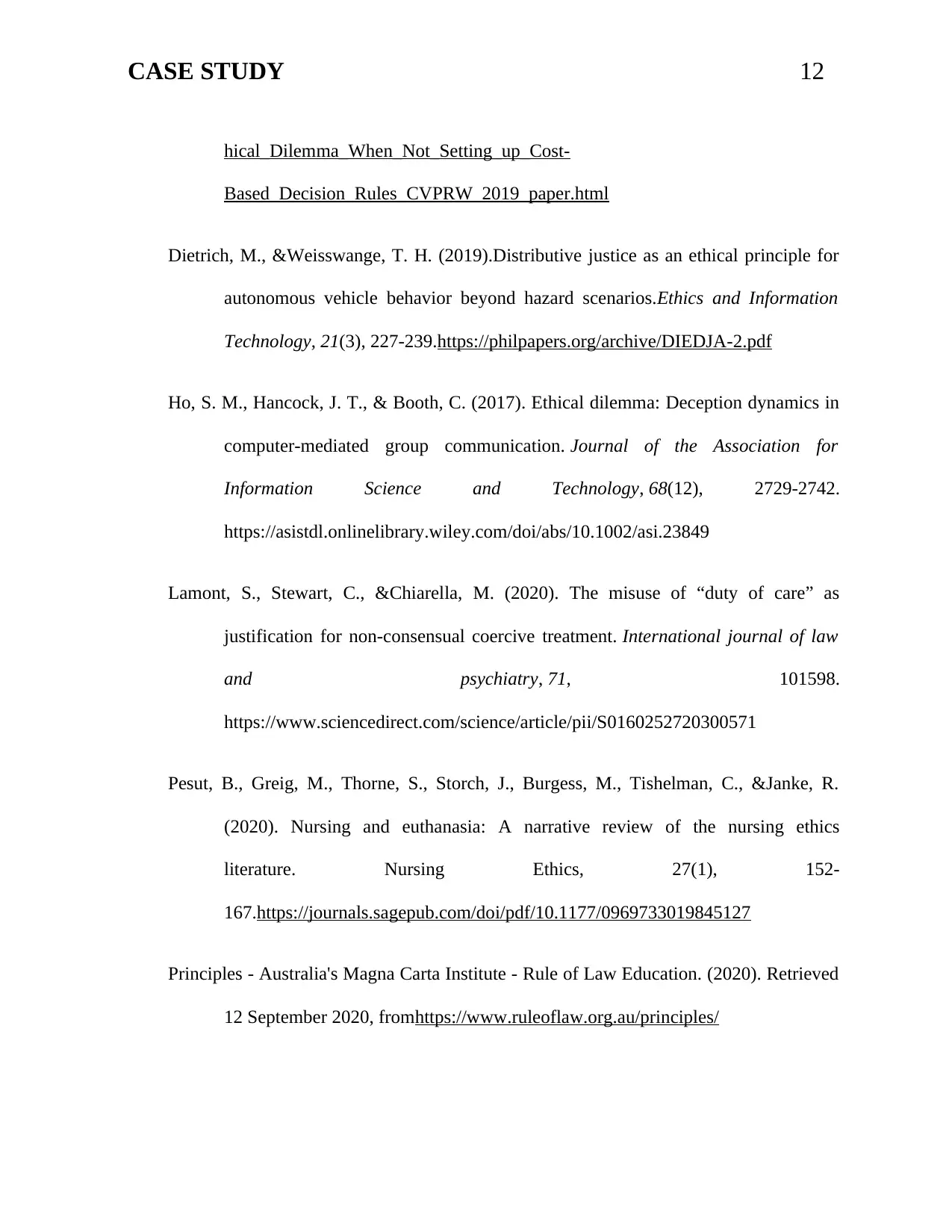
CASE STUDY 12
hical_Dilemma_When_Not_Setting_up_Cost-
Based_Decision_Rules_CVPRW_2019_paper.html
Dietrich, M., &Weisswange, T. H. (2019).Distributive justice as an ethical principle for
autonomous vehicle behavior beyond hazard scenarios.Ethics and Information
Technology, 21(3), 227-239.https://philpapers.org/archive/DIEDJA-2.pdf
Ho, S. M., Hancock, J. T., & Booth, C. (2017). Ethical dilemma: Deception dynamics in
computer‐mediated group communication. Journal of the Association for
Information Science and Technology, 68(12), 2729-2742.
https://asistdl.onlinelibrary.wiley.com/doi/abs/10.1002/asi.23849
Lamont, S., Stewart, C., &Chiarella, M. (2020). The misuse of “duty of care” as
justification for non-consensual coercive treatment. International journal of law
and psychiatry, 71, 101598.
https://www.sciencedirect.com/science/article/pii/S0160252720300571
Pesut, B., Greig, M., Thorne, S., Storch, J., Burgess, M., Tishelman, C., &Janke, R.
(2020). Nursing and euthanasia: A narrative review of the nursing ethics
literature. Nursing Ethics, 27(1), 152-
167.https://journals.sagepub.com/doi/pdf/10.1177/0969733019845127
Principles - Australia's Magna Carta Institute - Rule of Law Education. (2020). Retrieved
12 September 2020, fromhttps://www.ruleoflaw.org.au/principles/
hical_Dilemma_When_Not_Setting_up_Cost-
Based_Decision_Rules_CVPRW_2019_paper.html
Dietrich, M., &Weisswange, T. H. (2019).Distributive justice as an ethical principle for
autonomous vehicle behavior beyond hazard scenarios.Ethics and Information
Technology, 21(3), 227-239.https://philpapers.org/archive/DIEDJA-2.pdf
Ho, S. M., Hancock, J. T., & Booth, C. (2017). Ethical dilemma: Deception dynamics in
computer‐mediated group communication. Journal of the Association for
Information Science and Technology, 68(12), 2729-2742.
https://asistdl.onlinelibrary.wiley.com/doi/abs/10.1002/asi.23849
Lamont, S., Stewart, C., &Chiarella, M. (2020). The misuse of “duty of care” as
justification for non-consensual coercive treatment. International journal of law
and psychiatry, 71, 101598.
https://www.sciencedirect.com/science/article/pii/S0160252720300571
Pesut, B., Greig, M., Thorne, S., Storch, J., Burgess, M., Tishelman, C., &Janke, R.
(2020). Nursing and euthanasia: A narrative review of the nursing ethics
literature. Nursing Ethics, 27(1), 152-
167.https://journals.sagepub.com/doi/pdf/10.1177/0969733019845127
Principles - Australia's Magna Carta Institute - Rule of Law Education. (2020). Retrieved
12 September 2020, fromhttps://www.ruleoflaw.org.au/principles/
⊘ This is a preview!⊘
Do you want full access?
Subscribe today to unlock all pages.

Trusted by 1+ million students worldwide
1 out of 14
Related Documents
Your All-in-One AI-Powered Toolkit for Academic Success.
+13062052269
info@desklib.com
Available 24*7 on WhatsApp / Email
![[object Object]](/_next/static/media/star-bottom.7253800d.svg)
Unlock your academic potential
Copyright © 2020–2025 A2Z Services. All Rights Reserved. Developed and managed by ZUCOL.





